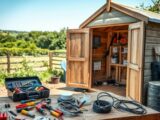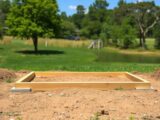What Is Tongue and Groove Cladding?

Tongue and groove cladding represents an innovative architectural technique that transforms building surfaces with exceptional precision and aesthetic appeal. This unique interlocking boards system creates a seamless, tight-fitting finish for both interior and exterior applications across residential and commercial spaces.
T&G cladding distinguishes itself through a clever mechanical design where each board features a protruding ‘tongue’ that precisely fits into a corresponding ‘groove’ on adjacent boards. This ingenious construction method ensures a smooth, uniform surface while providing excellent weather protection and structural integrity.
Architects and builders throughout the United Kingdom have embraced tongue and groove cladding for its versatility, durability, and clean visual appearance. Whether used in traditional countryside cottages or modern urban developments, this cladding technique offers remarkable design flexibility.
Inhaltsverzeichnis
Key Takeaways
- Innovative interlocking board system
- Provides seamless surface coverage
- Suitable for interior and exterior applications
- Enhances structural protection
- Offers exceptional design versatility
Understanding Tongue and Groove Cladding Basics
Tongue and groove (T&G) cladding represents a sophisticated building technique that has transformed architectural design and construction. This innovative interlocking mechanism creates seamless, robust surfaces for both interior and exterior applications.
The Interlocking Mechanism Explained
The interlocking mechanism is the heart of T&G design. Each board features a protruding tongue on one edge and a corresponding groove on the opposite side. When installed, these precision-cut edges slide together, creating a tight, weatherproof seal.
- Tongue protrudes outward from the board’s edge
- Groove creates a recessed channel
- Boards interlock smoothly without visible gaps
Common Materials Used in T&G Cladding
T&G materials vary widely, offering solutions for different environments and aesthetic preferences.
| Material | Characteristics | Best Use |
|---|---|---|
| Cedar Wood | Natural resistance to decay | Exterior cladding |
| Pine | Affordable, lightweight | Interior panelling |
| PVC | Low maintenance | Moisture-prone areas |
Historical Development of the Design
Cladding history traces back to traditional carpentry techniques. Craftsmen developed the tongue and groove method to create stronger, more stable wooden structures. The design emerged in the late 19th century, revolutionising construction by providing superior joint integrity.
“The tongue and groove technique represents a pinnacle of architectural craftsmanship” – Architecture Monthly
Benefits of Installing Tongue and Groove Cladding
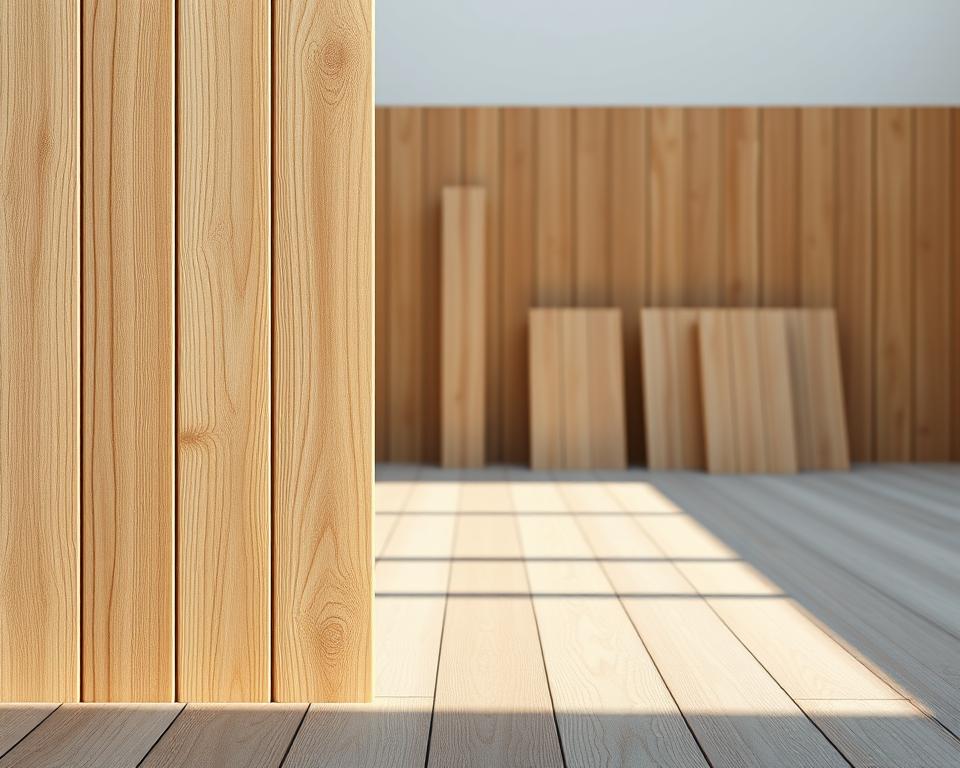
Tongue and groove (T&G) cladding offers remarkable advantages for homeowners and builders seeking high-performance exterior and interior finishes. The unique interlocking design provides exceptional benefits that make it a preferred choice for various construction projects.
Key T&G cladding advantages include:
- Superior weatherproofing capabilities
- Enhanced structural integrity
- Excellent thermal insulation properties
- Aesthetic versatility across different architectural styles
- Robust protection against environmental elements
The benefits of tongue and groove extend beyond basic protection. Each board’s precise interlocking mechanism creates a seamless surface that prevents water penetration and minimises heat loss. This design significantly improves a building’s energy efficiency and reduces long-term maintenance requirements.
Durability stands out as another critical advantage of T&G cladding. The tight-fitting joints resist warping, shrinking, and expanding, ensuring a stable and long-lasting exterior or interior finish. Homeowners can expect reduced repair costs and extended product lifespan compared to traditional cladding methods.
Professional builders consistently recommend tongue and groove cladding for its unmatched combination of functionality and aesthetic appeal.
Installation simplicity further enhances the attractiveness of T&G cladding. The standardised profile allows for quick, straightforward mounting, reducing labour costs and project completion times. Whether used in residential or commercial settings, this cladding solution delivers exceptional value and performance.
What Is Tongue and Groove Cladding?
Tongue and groove cladding represents a sophisticated wood joining technique that transforms ordinary building materials into precision-engineered solutions. Understanding the intricate details of T&G joint components helps professionals and DIY enthusiasts appreciate this remarkable construction method.
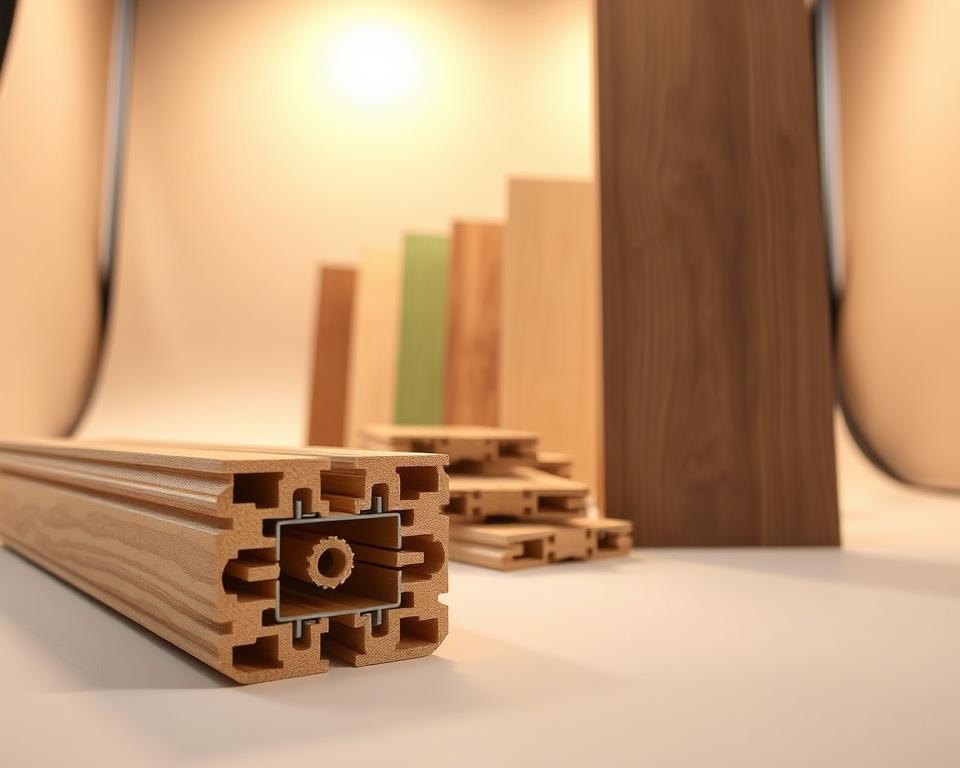
Key Components of T&G Joints
The T&G joint consists of two primary elements that create a seamless connection:
- Tongue: A protruding edge that extends from the board’s side
- Groove: A corresponding recessed channel that accepts the tongue
Cladding Profiles Explained
Different cladding profiles offer unique aesthetic and functional characteristics. Manufacturers produce various designs to suit specific architectural requirements:
| Profile Type | Best Application | Visual Characteristics |
|---|---|---|
| Shiplap | Exterior walls | Overlapping horizontal boards |
| Feather Edge | Rustic settings | Tapered board design |
| Machined Square Edge | Modern interiors | Precise, clean lines |
Manufacturing Process Overview
The manufacturing process for T&G cladding involves precision machining to ensure perfect joint alignment. Skilled craftspeople and advanced machinery work together to create boards with exceptional accuracy.
- Select high-quality timber
- Machine precise tongue and groove profiles
- Sand and finish boards
- Quality control inspection
Interior vs Exterior Applications
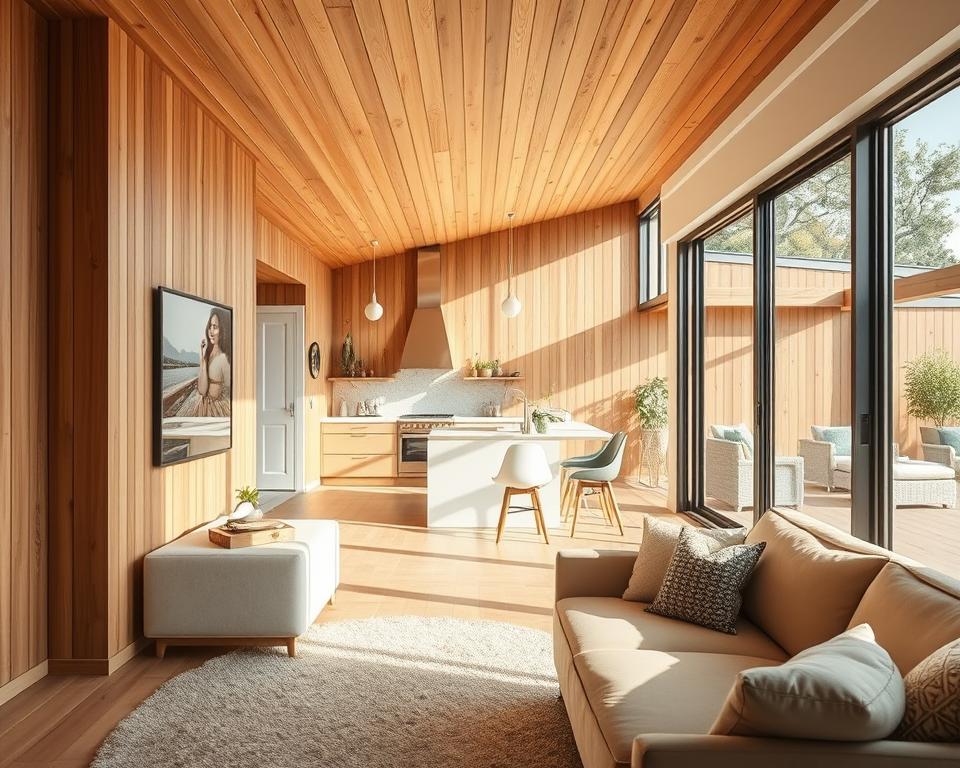
Tongue and groove cladding offers versatile solutions for both indoor T&G cladding and outdoor tongue and groove applications. The unique interlocking design makes it an exceptional choice for various architectural and design projects.
Exterior cladding applications demand robust materials that withstand environmental challenges. Wooden outdoor tongue and groove cladding provides excellent protection against weather elements while maintaining aesthetic appeal. Timber species like cedar and larch excel in outdoor settings due to their natural durability.
- Exterior applications require weather-resistant materials
- Choose timber with high moisture resistance
- Consider protective treatments for longevity
Indoor T&G cladding transforms interior spaces with elegance and warmth. Designers frequently use this technique in:
- Feature walls
- Ceiling treatments
- Decorative panelling
The versatility of cladding applications allows homeowners and architects to create unique visual experiences in both residential and commercial environments.
Selecting the right material is crucial for successful tongue and groove cladding installations.
Different environments require specific considerations. Moisture levels, temperature fluctuations, and aesthetic requirements play significant roles in determining the most suitable cladding approach.
Installation Methods and Best Practices
Successful tongue and groove (T&G) cladding installation requires careful planning and the right approach. This comprehensive T&G installation guide will walk you through the essential steps to achieve a professional finish.

Essential Cladding Tools for Your Project
Before beginning your T&G cladding project, gather these critical tools:
- Pneumatic nail gun or hammer
- Spirit level
- Measuring tape
- Saw (circular or mitre)
- Protective safety equipment
- Wood spacers
Step-by-Step Mounting Technique
Follow this systematic approach for seamless T&G cladding installation:
- Prepare the surface by ensuring it’s clean and level
- Install a moisture barrier if working on exterior surfaces
- Begin at the bottom, leaving small expansion gaps
- Interlock boards using the tongue and groove mechanism
- Secure each board using appropriate fixings
- Maintain consistent alignment throughout
Preventing Common Installation Mistakes
Avoid typical installation mistakes that can compromise your cladding’s appearance and durability:
- Inadequate spacing: Always allow for thermal expansion
- Incorrect moisture protection: Use appropriate barriers
- Poor board selection: Choose materials suited to your environment
- Inconsistent fixing: Ensure uniform attachment across boards
“Precision in installation determines the longevity and aesthetic appeal of your cladding project.” – Professional Carpentry Association
Maintenance and Care Guidelines
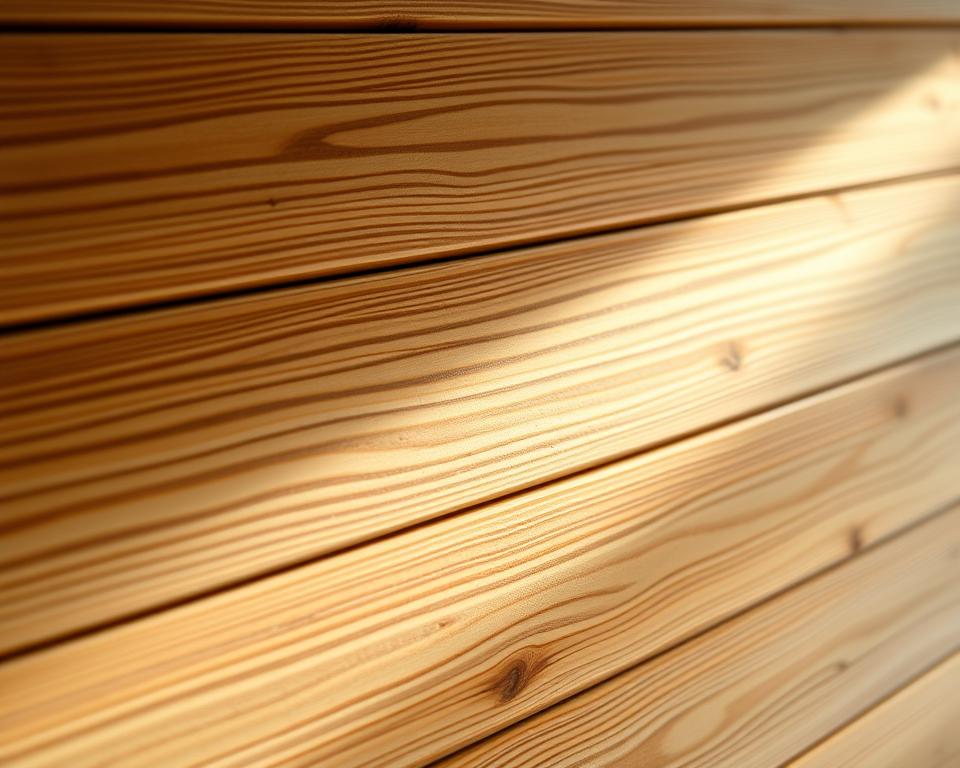
Proper T&G cladding maintenance is crucial for preserving the beauty and durability of your wooden surfaces. Regular care helps prevent damage and extends the lifespan of your investment.
Caring for tongue and groove requires a systematic approach. Start with routine cleaning and inspection to catch potential issues early.
- Cleaning techniques for different environments
- Protective treatments
- Seasonal maintenance strategies
- Addressing common wear and tear
When performing T&G cladding maintenance, consider these key steps:
- Regular cleaning: Use soft brushes and mild detergents
- Check for moisture damage
- Apply protective sealants annually
- Inspect for loose or damaged boards
Exterior cladding demands more rigorous maintenance due to exposure to weather conditions. Wooden surfaces need protection against UV rays, moisture, and temperature fluctuations.
Consistent care prevents costly replacements and maintains your cladding’s aesthetic appeal.
For interior applications, dust and clean regularly to prevent dirt accumulation. Use appropriate wood cleaning products that won’t damage the delicate tongue and groove joints.
Cost Considerations and Budget Planning
Navigating the financial landscape of tongue and groove (T&G) cladding requires careful budget planning and strategic decision-making. Understanding T&G cladding costs is crucial for homeowners and builders looking to create stunning exterior or interior finishes.
Material Price Comparisons
When exploring T&G cladding options, material costs can vary significantly. Different materials offer unique price points and characteristics:
- Softwood (pine): £10-£20 per square metre
- Hardwood (oak): £30-£50 per square metre
- Composite materials: £25-£40 per square metre
- Engineered wood: £20-£35 per square metre
Installation Cost Factors
Several elements influence the overall installation expenses for T&G cladding:
- Labour rates in your region
- Complexity of the project
- Surface preparation requirements
- Additional treatments or finishes
Long-term Value Assessment
Investing in high-quality T&G cladding offers substantial long-term value. Durability, energy efficiency, and aesthetic appeal contribute to potential property value increases. Homeowners can expect improved insulation, reduced maintenance costs, and enhanced kerb appeal.
Smart budget planning transforms T&G cladding from an expense to a valuable home investment.
When calculating your budget, consider not just initial costs but the entire lifecycle of your cladding project. Quality materials and professional installation might seem expensive initially but can save significant money in future maintenance and replacement expenses.
Design Ideas and Styling Options
T&G cladding designs offer remarkable versatility for homeowners seeking to transform their living spaces. These innovative styling tongue and groove solutions provide endless opportunities to create unique architectural statements both inside and outside the home.
Exploring creative T&G cladding designs requires understanding different aesthetic approaches. Designers can leverage various techniques to maximise visual impact:
- Vertical panelling for heightened room perception
- Horizontal layouts for contemporary minimalist styles
- Diagonal installations creating dynamic visual interest
- Mixed material combinations for textural depth
Colour selection plays a crucial role in styling tongue and groove applications. Neutral tones provide timeless elegance, while bold colours can create dramatic statements.
| Design Style | Colour Palette | Visual Effect |
|---|---|---|
| Scandinavian | White, Light Grey | Clean, Spacious |
| Rustic | Natural Wood Tones | Warm, Organic |
| Modern | Charcoal, Slate | Sleek, Contemporary |
When considering T&G cladding designs, professionals recommend experimenting with different finishes like matte, glossy, or distressed to achieve desired aesthetic outcomes.
Environmental Impact and Sustainability
Sustainable building practices have become increasingly crucial in modern construction. Tongue and groove cladding presents an exciting opportunity for environmentally conscious homeowners and builders to reduce their ecological footprint while maintaining aesthetic appeal.
The world of eco-friendly cladding has transformed dramatically in recent years. Sustainable T&G cladding now offers multiple environmentally responsible options that minimise carbon footprint without compromising quality or design.
Eco-friendly Material Selections
When considering sustainable T&G cladding, several material choices stand out:
- Reclaimed timber from responsible sources
- FSC-certified wood products
- Locally sourced renewable timber
- Bamboo-based cladding materials
Carbon Footprint Considerations
Reducing the environmental impact of construction materials requires careful evaluation. Eco-friendly cladding options can significantly decrease overall carbon emissions through:
- Selecting materials with low embodied energy
- Choosing locally produced timber
- Implementing efficient manufacturing processes
- Selecting durable materials that require minimal replacement
“Sustainable construction is not just a trend, but a necessary evolution in building design.” – Environmental Design Institute
Homeowners and architects can make substantial environmental contributions by selecting sustainable T&G cladding that prioritises ecological responsibility without sacrificing aesthetic or functional performance.
Common Problems and Solutions
Tongue and groove cladding presents unique challenges for homeowners and builders. Understanding common T&G cladding issues helps prevent long-term damage and maintain the structural integrity of your property.
Moisture damage ranks as the most prevalent problem in tongue and groove cladding. Wood naturally absorbs water, which can lead to significant structural concerns if left unchecked. Troubleshooting tongue and groove installations requires proactive moisture management strategies.
- Inspect boards regularly for water penetration
- Apply water-resistant sealants
- Ensure proper ventilation behind cladding
- Check for early signs of wood rot
Insect infestation presents another critical challenge for T&G cladding systems. Woodworm, termites, and carpenter ants can compromise the structural integrity of your cladding, creating extensive damage if not addressed promptly.
Warping and gaps between boards are typical T&G cladding issues that arise from temperature fluctuations and improper installation. Selecting high-quality, well-seasoned timber and maintaining consistent environmental conditions can mitigate these problems.
- Use kiln-dried timber
- Allow wood to acclimatise before installation
- Leave appropriate expansion gaps
- Use professional installation techniques
Preventative maintenance remains key to addressing potential tongue and groove cladding challenges. Regular inspections, timely repairs, and professional assessments can extend the lifespan of your cladding significantly.
Choosing the Right Type for Your Project
Selecting the perfect tongue and groove (T&G) cladding requires careful consideration of multiple factors. Your choice will impact both the aesthetic appeal and long-term performance of your property’s exterior or interior surfaces.
When selecting T&G cladding, homeowners must evaluate several critical aspects to ensure optimal results. The right selection depends on understanding your specific environmental conditions and architectural style.
Climate Considerations for Cladding
Cladding for different climates demands strategic material selection. Each environment presents unique challenges that influence your cladding choice:
- Coastal regions require corrosion-resistant materials
- Humid areas need moisture-tolerant options
- Extreme temperature zones demand thermal-stable cladding
Matching Property Style
Your property’s architectural character plays a crucial role in selecting appropriate T&G cladding. Different styles harmonise with specific materials and finishes:
- Traditional Properties: Wooden cedar or oak cladding
- Modern Homes: Sleek composite or aluminium profiles
- Rustic Settings: Reclaimed timber or weathered finishes
Professional consultation can help you navigate these complex decisions, ensuring your cladding not only performs excellently but also enhances your property’s visual appeal.
Conclusion
Tongue and groove cladding stands out as a versatile and elegant solution for both interior and exterior design projects. The unique interlocking mechanism offers remarkable benefits that extend beyond simple aesthetic appeal. From improved weather resistance to exceptional structural integrity, T&G cladding provides homeowners and designers with a robust building material that combines functionality and style.
Understanding the tongue and groove cladding benefits means recognising its adaptability across various architectural styles and environments. Whether you’re renovating a traditional cottage in the Cotswolds or creating a modern urban space, this cladding technique offers unparalleled design flexibility. The range of materials available, from sustainable timber to contemporary composite options, ensures there’s a perfect match for every project requirement.
As you consider your next home improvement or construction venture, the T&G cladding summary highlights its potential to transform spaces. Proper installation, regular maintenance, and thoughtful material selection can unlock the full potential of this remarkable cladding technique. Architects, builders, and DIY enthusiasts alike can appreciate the seamless integration and visual appeal that tongue and groove cladding brings to any architectural design.
With careful planning and informed choices, tongue and groove cladding can elevate your project from ordinary to extraordinary. Embrace this timeless technique and discover the perfect blend of practicality and aesthetic excellence for your space.
FAQ
What exactly is tongue and groove cladding?
Tongue and groove cladding is a construction technique where wooden (or other material) boards interlock with a protruding ‘tongue’ on one edge fitting precisely into a corresponding ‘groove’ on another board’s edge, creating a seamless, tight-fitting surface for walls, floors, or ceilings.
Can tongue and groove cladding be used both inside and outside?
Yes, tongue and groove cladding is versatile and can be used for both interior and exterior applications. However, for external use, you’ll need to select materials specifically treated for weather resistance, such as pressure-treated timber or marine-grade materials.
What materials are commonly used for tongue and groove cladding?
The most popular materials include wood (pine, cedar, oak), PVC, composite materials, and occasionally metal. Each material offers different benefits in terms of durability, aesthetics, and cost.
How difficult is it to install tongue and groove cladding?
Installation complexity varies depending on your DIY skills. While experienced DIY enthusiasts can manage the project, beginners might find it challenging. Proper tools, precise measurements, and understanding the interlocking mechanism are crucial for a successful installation.
How do I maintain tongue and groove cladding?
Maintenance depends on the material. For wooden cladding, regular cleaning, occasional resealing or painting, and checking for moisture damage are essential. PVC and composite materials typically require less maintenance, usually just needing periodic cleaning.
What are the cost considerations for tongue and groove cladding?
Costs vary widely based on material choice, area to be covered, and installation complexity. Wooden cladding can range from £20-£100 per square metre, while PVC options might be slightly cheaper. Professional installation will add to the overall expense.
Is tongue and groove cladding environmentally friendly?
Sustainability depends on material sourcing. Reclaimed wood, FSC-certified timber, and recycled composite materials offer more environmentally friendly options. Some manufacturers now produce tongue and groove cladding with reduced carbon footprints.
How does climate affect tongue and groove cladding selection?
Climate is crucial in material selection. In damp environments, moisture-resistant materials like cedar or treated pine are recommended. In extreme temperature regions, materials with good thermal properties and expansion resistance are essential.
Can tongue and groove cladding improve home insulation?
Absolutely! When installed correctly with proper backing and insulation, tongue and groove cladding can significantly improve a building’s thermal efficiency, reducing heat loss and potentially lowering energy bills.
What design styles work well with tongue and groove cladding?
Tongue and groove cladding is incredibly versatile, suiting contemporary minimalist designs, rustic farmhouse aesthetics, Scandinavian-inspired interiors, and traditional architectural styles. The material and finish can be adapted to match various design preferences.
